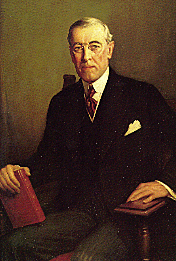

Health and Medical History of President
Woodrow WilsonLived 1856-1924
Health and Medical History of President
Woodrow WilsonLived 1856-1924
1776-1783
1812-1815
1846-1848
1861-1865
1898-1899
1917-1918
1941-1945
1950-1953
1964-1975
1990-1991
2001-2021

| UNDER CONSTRUCTION |
Comment: This is relevant to Wilson's later stroke(s) because poor dentition has been suspected to increase the risk of atherosclerotic disease.
Wilson's first stroke was in May 1896. It caused marked weakness of the right upper limb plus sensory disturbances in the fingers. The finger problems were mis-diagnosed as neuritis. Wilson was unable to write normally for almost a year afterwards. Comment: There may be some dispute about this event, in a later article in the New England Journal of Medicine.
- November 1907 -- Developed weakness and numbness of fingers or right upper limb that lasted several months;
- July 1908 -- Two attacks of "neuritis" affecting the right upper limb;
- December 1910 -- Transitory weakness of the right hand.
- April 1913 -- Attack of "neuritis" involving right upper limb;
- May 1914 -- Abnormal retinal arteries observed;
- May-Sept. 1915 -- Episodes of transient weakness in his right hand.
Dr. Grayson sat up with Wilson all night. Vomiting and diarrhea developed. The fever did not break. Wilson could not sleep, which was unusual for him. Grayson decided it was influenza. The President stayed in bed the next day and from there even held meetings with rulers who braved the sick room. 1b
A night of burning fever followed, after which Grayson and Mrs. Wilson forbade all work. Wilson then slept for three days, fitfully. 1c
He awoke a subtly changed man. He suspected the French servants were spying. He worried that furnishings were being stolen. He scrutinized his delegation's use of automobiles to make sure they were used only for official purposes -- he had previously encouraged the cooped-up staff to take them for relaxing drives and trips. With his physician, he rearranged furnishings in his room. He suspected his closest aide of trying to subvert him. He was dour, secretive, impatient, and petulant, yet continued to do brilliant work. 1d
Comment: What happened to Wilson's cognition? Possibilities include a stroke-like event or encephalitis (brain inflammation) from what appears to have been an infection with the fearsome 1918 influenza virus. No matter what the cause, this change in Wilson has come to be viewed as an inciting event for World War II -- the theory being that Wilson lost the political astuteness that would have enabled him to presuade the Senate to ratify the League of Nations Treaty, which Wilson viewed as the sole means to prevent another global conflict within a generation.
With his long history of arterial disease in the brain and eye, Wilson was not healthy when he set out. He was to get much worse during the trip, experiencing severe headaches, double vision, difficulty breathing, and signs of a weakened heart. The tour was canceled when he developed unmistakable signs of a stroke, though these later eased 5.
Wilson's wife called the journey "one long nightmare" 1f. Dr. Cary Grayson, who was on the trip, described it as "a prolonged agony of physical pain" 1f -- pain that he was unable to treat (no physician in that era could have).
Wilson's condition was hidden from his Cabinet, from the Vice President and, of course, from the public. This could only be done by keeping Wilson physically isolated. Some members of the Cabinet were uneasy. On Oct. 5, 1919, ex-President Taft wrote to A. L. Lowell 11a:
[Secretary of the Treasury] McAdoo says the President [Wilson] is in a state of collapse -- that his mind is clear but that he is so weak that his doctors would not permit him to discuss or think about any of these matters. ... He says that he would like to help, but he is in a delicate situation, being the son-in-law of the President.Taft was no fan of Woodrow Wilson, but it is interesting that even an ex-President in the opposing political party did not (could not?) act on behalf of the people.
The White House maid, too, thought Wilson's mind was clear, but agonized at the twisted smiles that he would give her -- only half of his face worked. The Secret Service would seat him in his car so the public could not see the paralyzed side. 7d
The stroke was first disclosed to the public four months later, by Dr. Hugh Young who had consulted on Wilson's inability to urinate 12.
This may be an exaggeration, however. Dr. Mark Benbow of the Woodrow Wilson House reports that "He didn't actually try to catch speeders himself, but he did send his secret service agents after them in their separate car. They would usually come back and claim that the speeder was going too fast so they could not catch them. Wilson also asked his Attorney General if he had the power to give speeding tickets. The Attorney General said no. This probably started before Wilson had his stroke. The speed limit in Washington then was 22 mph" 13 [? source = "Starling of the White House"]. Wilson used to tease his family and friends at the dinner table asking "Well, who's been pinched today?" 5a.
Questions about Wilson's sanity entered the public sphere, including a rumor that iron bars had to be installed on his bedroom windows. In actuality, the bars had been installed years earlier to protect Theodore Roosevelt's children. Another disparaging report misquoted the Queen of Belgium saying Wilson was dressed in a torn wool sweater during her White House visit. She had said warm wool sweater. 7e
Still, there were noticeable changes in Wilson's personality after the stroke. The White House maid described a childish irritability, and pouting when he would not get his way 7d.
- Wilson's first wife died of renal tuberculosis, in the White House 3e.
- Unlike James Polk and William McKinley, both of whom carefully studied the art of shaking hands, Wilson's handshake was described as "a ten-cent pickled mackerel in brown paper" 4a.
- When Wilson suffered his collapse (stroke) while campaigning for the League of Nations, former President Taft, although a supporter of the League, was critical: "He has so insisted on hogging all the authority -- trusting no one -- that he has broken himself down" 15a.
- From
16a:
There is a story told of Wilson that he asked a caller if he knew the hardest job a President faced every day.
"No," was the response, "because I have never been President."
"I'll tell you then," replied Wilson, "it is in keeping your temper."
- Physicians called to consult on Wilson's stroke by Presidential physician Dr. Cary T. Grayson were 8b: Dr. Sterling Ruffin, Dr. Edward Stitt, Dr. Francis Dercum, Dr. Henry Fowler, Dr. Hugh Young, Dr. George De Schweinitz, and Dr. Charles Mayo. At intervals, Dr. Edward Davis would confer with Grayson about Wilson's case. In Wilson's final illness, Drs. Ruffin and Fowler were again called in consultation 8c.
- Two years before becoming First Lady, Mrs. Warren Harding said: "I've seen the inside of the White House. The office is killing Wilson as surely as if he had been stabbed at his desk. Don't ask Warren to run." 16b
- Wilson dropped the use of his first name (Thomas) in a "search for something more sonorous and distinctive." 17a
- Wilson's eldest daughter, Margaret Woodrow Wilson (who looked shockingly like him), died of uremia 7f.
- The second Mrs. Wilson was part Native American and claimed descent from Pocahontas 7g. (Herbert Hoover's vice president, Charles Curtis, was also said to be part Native American 7h.)
- Smith, Gene. When the Cheering Stopped: The Last Years of Woodrow Wilson. New York: William Morrow and Company, 1964.
a p.x b p.48 c p.49 d pp.49-50 e p.60 f p.283 g pp.60-85. Unfortunately, Smith does not provide specific sources for specific statements. Thus, it should not always be presumed that dates, places, and events are precisely correct.
- Available on the web: http://www.woodrowwilsonhouse.org/funfacts.htm
- MacMahon, Edward B. and Curry, Leonard. Medical Cover-Ups in the White House. Washington, DC: Farragut, 1987.
 a p.65 b p.5 c pp.56-77 d p.75 e p.64
a p.65 b p.5 c pp.56-77 d p.75 e p.64 - Boller, Paul F. Jr. Presidential Anecdotes. New York: Oxford University Press, 1981.
 a p.218
a p.218 - Weinstein, Edwin A. Woodrow Wilson: A Medical and Psychological Biography. Princeton, NJ: Princeton University Press, 1981.
a p.260 per Dr. Benbow
- Anonymous. President Wilson Ill Again. New York Times. December 12, 1913; Page 1.
- Parks, Lillian Rogers. My Thirty Years Backstairs at the White House. New York: Fleet Publishing, 1961.
a p.143 b p.135 c p.149 d p.157 e pp.156-157 f pp.147-148 g pp.148-149, 223 h p.223
Comment: This book stayed on the New York Times best-seller list for 26 weeks, prompting Jacqueline Kennedy to require all staff at the White House to sign a pledge agreeing not to write about their experiences (NY Times, page B8, Nov. 12, 1997). Parks's mother, a maid at the White House from 1909-1939, had actually been encouraged by Eleanor Roosevelt to write and publish a memoir (p260).
- Grayson, CT. Woodrow Wilson -- An Intimate Memoir. New York: Holt, Rhinehart, Winston, 1960.
a pp.96-100 b p.100 c p.110
Comment: Grayson was Wilson's physician during his entire tenure as President. No presidential physician before or since Grayson has had as close a relationship with the Chief Executive. It is remarkable that, in his book, Grayson devotes only one paragraph to Wilson's stroke (page 100).
- Park, Bert Edward. The Impact of Illness of World Leaders. Philadelphia: University of Pennsylvania Press, 1986.
 a pp.3-76
a pp.3-76 - Post, Jerrold M. and Robins, Robert S. When Illness Strikes the Leader: The Dilemma of the Captive King. New Haven, CT: Yale University Press, 1993.
 a pp.85-90
a pp.85-90Comment: At one time Post worked for the CIA, profiling foreign leaders.
- Pringle, Henry F. The Life and Times of William Howard Taft: A Biography. New York: Farrar & Rinehart, Inc., 1939.
 a p.927
a p.927 - Loughlin, Kevin R. Hugh Hampton Young at the Bedside of Woodrow Wilson: The President, the Urologist, and the First Lady. Urology. 2017: 100: 1-5. Pubmed: 27810357. DOI: https://doi.org/10.1016/j.urology.2016.10.037 Also available on the web at: https://www.goldjournal.net/article/S0090-4295(16)30764-6/fulltext
- Benbow, Mark. Personal communication, July 2, 2003.
- Longworth, Alice Roosevelt. Crowded Hours. New York: Charles Scribner's Sons, 1933.
a p.323
- Ross, Ishbel. An American Family: The Tafts - 1678 to 1964. Cleveland, OH: World Publishing Co., 1964.
a p.316
- Stoddard, Henry L. It Costs to Be President. New York: Harper & Brothers, 1938.
 a p.126 b pp.22, 81
a p.126 b pp.22, 81Comment: Stoddard was editor and owner of the New York Evening Mail from 1900 to 1925.
- Montgomery-Massingberd, Hugh (ed). Burke's Presidential Families of the United States of America. 2nd ed. London: Burke's Peerage Limited, 1981.
 a p.433
a p.433Comment: Maps -- in great detail -- the ancestors and descendants of American presidents through Ronald Reagan. They would have had an exhausting time with President Obama's family tree! MORE





